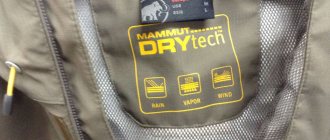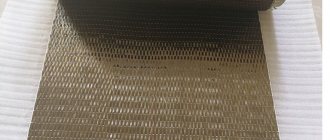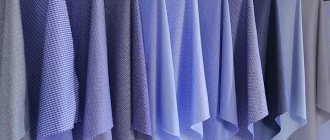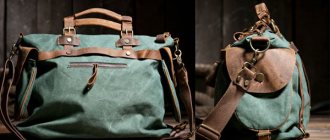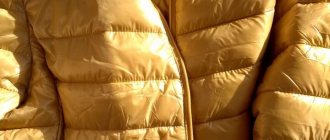Origin story
Nylon was invented by Carothers in 1935, and in 1938 the fabric became in demand. It was typically used to make women's stockings, toothbrush bristles, and parachutes. In the post-war period, nylon was used to sew various clothes. It was perfect for the production of underwear, skirts, blouses, shirts, raincoats and various accessories.
Nylon colors
The history of nylon fabric
Before considering the question of what kind of fabric nylon is, it is necessary to familiarize yourself with the history of its origin. The material first appeared in 1935, and was developed by chemist Wallace Hume Carothers. At the time, he was working for the chemical company DuPont. The discovery of nylon at that time was accidental.
Nylon fabric
The chemist simply studied chemical processes in a new direction. It has been determined that some polymers, when stretched, produce a very thin thread. As a result, it became clear that special weaving can give a certain density to the resulting fabric.
The chemist managed to preliminarily create a polymer, which was not put on sale, but underwent additional processing and was later named nylon. Together with this polymer, neoprene and polyester were created by the chemist Carothers. But that was later. 3 years after the production of the first test polymer, the modified nylon entered the industrial network.
Advantages and disadvantages
Pros:
- Strength.
- Waterproof and stain resistant.
- Fast drying.
- Ability to stretch and quickly regain shape.
- Low price.
- High-quality protection from the cold.
- Variety and brightness of color.
- Easy to care for.
Minuses:
- Possibility of allergies (can be avoided if worn over other clothing).
- Poor air permeability.
- Unadapted to high temperatures.
- Poor reaction to moisture.
- Highly electrified (use of antistatic spray is recommended to avoid this problem).
- Does not withstand exposure to chlorine.
Types of nylon fabrics
A description of nylon fabric cannot occur without considering the varieties of the material. This is necessary to study the scope of each type.
At the moment, production has expanded, and manufacturers can reinforce it, impregnate it with additional substances, and add fibers to improve the properties of the material. As a result, the following types of nylon fabric can be distinguished:
- Elastic nylon - elastomers are added to nylon threads. These are polymer fibers with increased elongation. Here elastane is distinguished, which has additional names - lycra or spandex. These fabrics have bright colors, they are soft on the skin and have good stretch. Tracksuits are mainly made from elastic nylon.
- Ripstop is the same nylon that is pre-reinforced, in other words, stitched with additional threads with stitches of 5-8 mm to improve strength. The result is a mesh, and clothes made from the presented material are durable. If the fabric is pierced by some sharp object, you will end up with a small hole the size of one reinforced cell. Ripstop is used for sewing camping equipment, awnings, awnings and other household items.
- Cordura is, in fact, the name of the brand. But it was the brand’s employees who developed the production technology for the presented fabric. In this case, the material contains cut and twisted fibers, which produces a durable fabric used in sewing military or tourist equipment.
Kevlar glove
- Kevlar differs from “standard” nylon by one group of atoms. As a result, there are no differences in appearance and basic properties, but several layers of Kevlar, unlike the original type, can stop a bullet. The material is used for sewing shoes and equipment for motorcyclists.
You might be interested in what is special about tent fabrics and where are they used?
This is not the entire classification of varieties. But liquid and reinforced types should be distinguished separately.
Liquid nylon
Liquid nylon is a mixture of natural fibers and ultra-thin elastane. The production of such fabric is mainly carried out by manufacturers of women's stockings. Additionally, you can highlight underwear and various sexy jumpsuits. In its properties and appearance, liquid nylon is similar to latex, but it is much thinner and stronger.
Liquid nylon
Reinforced nylon
The principle of nylon reinforcement was written above. But the reinforcement can be so strong that more complex household items are made from the finished material - dentures, filtration devices, wrenches, pipe connectors and other things. It is noteworthy that these products will be of much higher quality than aluminum, but are offered at the price of plastic. What is the reason?
The production uses 3D technologies, where Kevlar, fiberglass and carbon are used for additional reinforcement of nylon. The products have already begun to be made, but their supply is still limited. Buyers are also wary of the production of such items, since they are currently accustomed only to the strength of nylon lines. But the novelty is gradually entering the everyday life of citizens.
Reinforced nylon
approximate cost
Compared to natural fabrics, nylon has very low prices, but prices can vary greatly. On average, fabric can cost from 100 to 1000 rubles per meter in popular online stores. Nylon clothing can also be chosen to suit any budget - there are both very cheap models and high-quality items costing up to 20,000 rubles.
Despite the synthetic material, nylon clothing is suitable for daily use. The scope of application is very wide and extends to all spheres of society. This is facilitated by the practicality and beauty of the fabric.
Properties and Application
To determine exactly what nylon is, it is necessary to consider the basic properties of the material and the principle of its manufacture. Nylon is a 100% chemical compound that is made by first combining adipic acid and hexamethylenediamine. This produces a chemical reaction that produces salt. Solvents are added to the salt and the resulting mixture is heated. By heating, polyamide is obtained - this is a plastic intended for the production of fabric fibers.
Properties of nylon
This is interesting! Thanks to the presented technology, a plastic is obtained that is excellent for both the manufacture of tableware and the production of material. As a result, you can draw your own conclusion - the density and strength of the material are at a high level, allowing for sewing bags, travel equipment, awnings and other products.
Does it get wet or not?
Nylon fabric is offered today by several manufacturers. The production of the brand is similar to the main method of obtaining fabric, but with some minor differences. As a result, we can highlight the most popular varieties:
- Taslan Offman (100%) is the thickest and most durable polyamide (this is the second name). It always repels water, moisture collects in drops and flows off.
- Complex Finetex (100%) - has high strength and fully repels water.
- Finetex (100%) - has a microporous structure, which makes it highly durable and repels water.
- Elide (100%) - porous structure, ultra-thin nylon. Despite the presented characteristics of nylon fabric, it is durable and does not get wet. The material is warm and soft.
You might be interested in what PAN means in a fabric: combination with wool and material properties
When considering what kind of material nylon is, most buyers confuse it with polyester. Indeed, the canvases are similar in appearance and properties. But polyester is made from other chemical elements - polyester from a petroleum product is used. Due to the nature of production, the material does not have the lightness of nylon. But the fabric has a high density, hence it is used in sewing outerwear and more durable household items.
Does it stretch or not?
The properties of nylon depend on its composition. So, it is impossible to answer exactly whether nylon stretches or not unless you consider the composition of the proposed fabric. Pure polyamide does not stretch. But if the fibers are mixed with Lycra fibers, the result is a stretchy material.
Strength
It is almost impossible to tear nylon by hand. This is explained by the special arrangement of fibers that prevent tearing. Moreover, the fiber itself is polyamide or plastic, which provides the characteristic strength of the fabric.
Density
The properties of nylon indicate that the material is dense, but at the same time it is elastic and lends itself to soft drapery. All-nylon fabric is capable of permeable air, but only slightly.
Note! For summer clothes made of nylon, it is better to choose finely porous fabrics. They are practical and also pleasantly cool the skin in hot weather.
Processing of polyamide parts
Minimal processing
The peculiarity of nylon is that the product can be used immediately after printing. If printing was done using easily soluble PVA support, then dissolving the supports in water will be the only action. To prevent warping, it is recommended to print products from nylon with raft - this is an additional layer on the base of the product that increases adhesion to the platform. When printing with raft, after removing the part from the platform, it is easily removed.
Painting
Painting finished nylon products is a fairly simple process. To work, you need a vessel with water, a dye for synthetic materials, a weight to hold the product in water, a plate, and two vessels for painting and cooling. Before you start painting, you need to make sure that there are no traces of glue or masking tape left on the part. Dilute the required amount of dye in a vessel for painting, place the vessel on the stove and bring the temperature to 60 - 70 °C, lower the nylon product into the solution and wait a few minutes to obtain the color of optimal saturation. Then cool the painted part in cold water.
Gluing
Polyamide is a rather difficult material to glue. The simplest solution would be polyurethane glue, which is designed for gluing literally any materials. Another universal method is to use epoxy resin. Regular superglue (cyanoacrylate) can also be used, but excellent results are not guaranteed.
Precautionary measures
Harmful effects of polyamide are possible when processed at temperatures above 300 °C. In this case, toxic substances may be released: ammonia, carbon monoxide and carbon dioxide. In case of poisoning by decomposition products or inhalation of nylon dust, irritation of the upper respiratory tract occurs.
Although the polyamide 3D printing process does not produce an unpleasant odor, it is recommended to carry out work in a well-ventilated area.
How to bleach, wash and iron a nylon product
It is impossible to accurately answer the question of how to iron or wash nylon fabric, since everything depends on the type of material. In matters of product care, the following factors can be distinguished:
- Nylon does not wrinkle, so you don’t have to iron it at all if the structure of the fabric allows it. More rigid varieties can be ironed with a warm iron - for example, military uniform or tracksuit. Women's stockings, nightwear or pastel underwear can do without ironing.
- Only white nylon can be bleached. Colored fabrics will not retain their appearance. This is done with men's nylon shirts, which acquire a characteristic snow-white shine.
- Washing nylon products is easy because the fiber repels not only water, but also dirt. It is enough to use hand or machine wash - whichever the product allows.
Important! When purchasing nylon clothing or any product, it is recommended that you read the recommendations for caring for the item. Manufacturers always attach appropriate tags with the required water temperature for washing and possibly ironing the product.
You might be interested in: Components of polyester fabric and combinations with other materials
